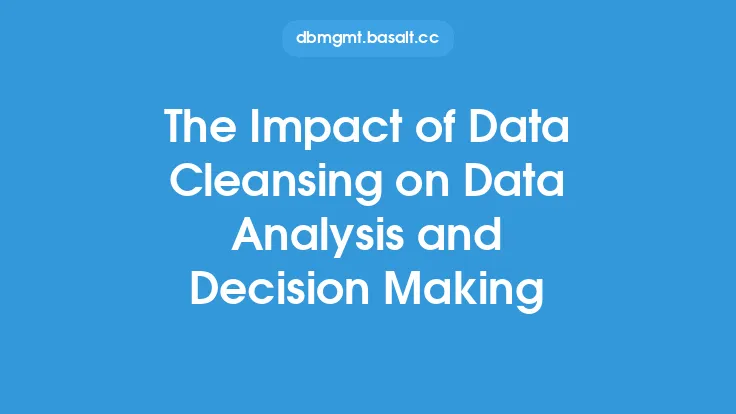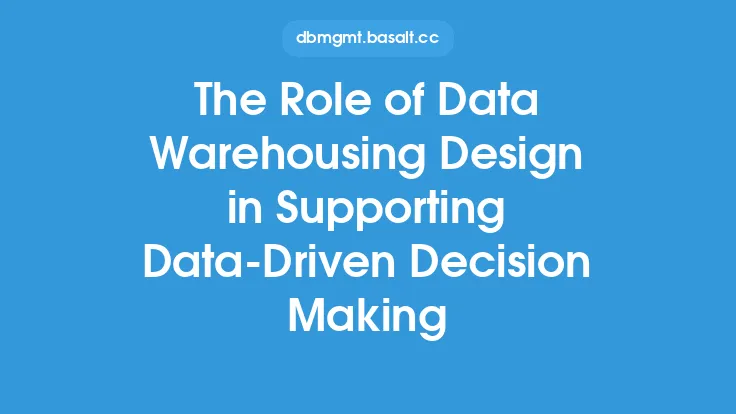Data modeling is a crucial aspect of data management, as it enables organizations to create a conceptual representation of their data assets. This representation is used to communicate the structure and relationships of data entities, making it easier to understand and analyze data. Data modeling standards play a vital role in ensuring that data models are consistent, accurate, and scalable. These standards provide a set of guidelines and best practices for creating data models, which helps to ensure that data is properly organized, defined, and related.
Introduction to Data Modeling Standards
Data modeling standards are a set of rules and guidelines that govern the creation and maintenance of data models. These standards are designed to ensure that data models are consistent, accurate, and scalable, and that they meet the needs of the organization. Data modeling standards typically cover aspects such as data entity definition, attribute definition, relationship definition, and data type definition. They also provide guidelines for naming conventions, data formatting, and data validation. By following data modeling standards, organizations can ensure that their data models are of high quality, and that they provide a solid foundation for data-driven decision making.
The Impact of Data Modeling Standards on Data-Driven Decision Making
Data modeling standards have a significant impact on data-driven decision making. By providing a consistent and accurate representation of data entities and relationships, data modeling standards enable organizations to make informed decisions based on reliable data. Data modeling standards also help to ensure that data is properly organized and defined, making it easier to analyze and interpret. This, in turn, enables organizations to identify trends, patterns, and insights that might not be apparent from raw data. Furthermore, data modeling standards help to reduce errors and inconsistencies in data, which can lead to incorrect decisions. By following data modeling standards, organizations can ensure that their data is trustworthy, and that it provides a solid foundation for data-driven decision making.
Key Components of Data Modeling Standards
Data modeling standards typically consist of several key components, including data entity definition, attribute definition, relationship definition, and data type definition. Data entity definition involves defining the structure and properties of data entities, such as customers, orders, and products. Attribute definition involves defining the characteristics of data entities, such as customer name, order date, and product price. Relationship definition involves defining the relationships between data entities, such as the relationship between customers and orders. Data type definition involves defining the data types used to represent data entities and attributes, such as integer, string, and date. These components work together to provide a comprehensive and consistent representation of data entities and relationships.
Data Modeling Notations and Techniques
Data modeling notations and techniques are used to create and represent data models. Some common data modeling notations and techniques include entity-relationship modeling (ERM), object-role modeling (ORM), and dimensional modeling. ERM is a notation that uses entities, attributes, and relationships to represent data models. ORM is a notation that uses objects, roles, and relationships to represent data models. Dimensional modeling is a technique that uses facts and dimensions to represent data models. These notations and techniques provide a visual representation of data models, making it easier to understand and communicate the structure and relationships of data entities.
Data Modeling Tools and Software
Data modeling tools and software are used to create, maintain, and manage data models. Some common data modeling tools and software include data modeling software, database management systems, and data integration tools. Data modeling software provides a graphical interface for creating and editing data models. Database management systems provide a platform for storing and managing data models. Data integration tools provide a platform for integrating data from multiple sources. These tools and software help to automate the data modeling process, making it easier to create and maintain high-quality data models.
Best Practices for Implementing Data Modeling Standards
Implementing data modeling standards requires a structured approach. Some best practices for implementing data modeling standards include establishing a data modeling team, defining data modeling standards, creating a data model repository, and providing training and support. Establishing a data modeling team helps to ensure that data modeling standards are consistently applied across the organization. Defining data modeling standards helps to ensure that data models are consistent and accurate. Creating a data model repository helps to store and manage data models, making it easier to access and maintain them. Providing training and support helps to ensure that data modeling standards are understood and applied correctly.
Challenges and Limitations of Data Modeling Standards
Data modeling standards can be challenging to implement and maintain. Some common challenges and limitations of data modeling standards include data complexity, data volume, and data variability. Data complexity can make it difficult to create and maintain data models, especially in organizations with complex data structures. Data volume can make it difficult to manage and maintain large amounts of data, especially in organizations with big data. Data variability can make it difficult to create and maintain data models, especially in organizations with diverse data sources. To overcome these challenges, organizations need to invest in data modeling tools and software, provide training and support, and establish a data modeling team.
Conclusion
Data modeling standards are a crucial aspect of data management, as they enable organizations to create a conceptual representation of their data assets. By following data modeling standards, organizations can ensure that their data models are consistent, accurate, and scalable, and that they provide a solid foundation for data-driven decision making. Data modeling standards have a significant impact on data-driven decision making, as they enable organizations to make informed decisions based on reliable data. By understanding the key components of data modeling standards, data modeling notations and techniques, data modeling tools and software, and best practices for implementing data modeling standards, organizations can create high-quality data models that support their business needs.





